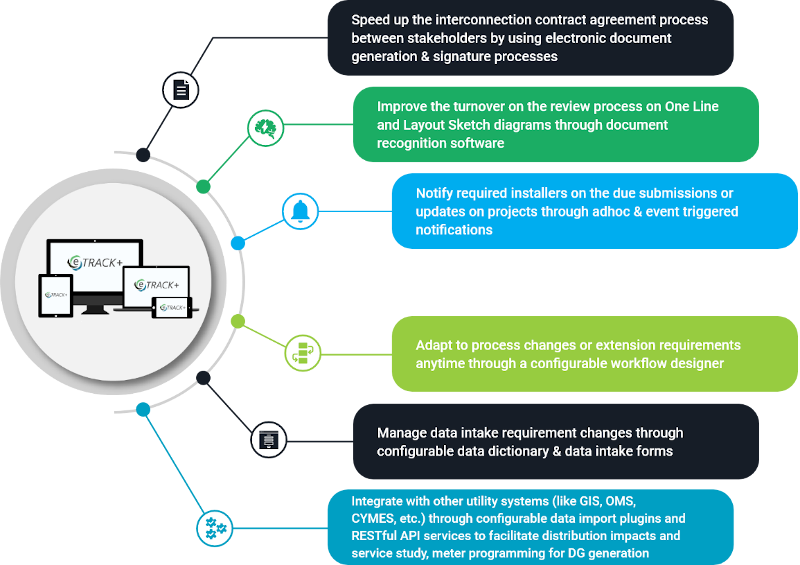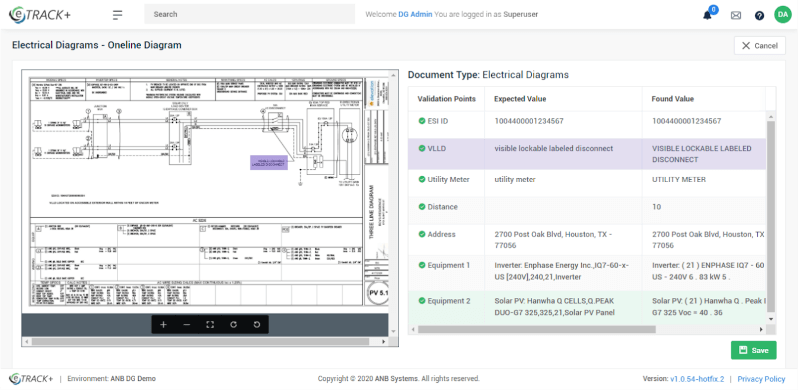Automating the Utility-Customer DER Interconnection Process
By Abhishek Balakrishnan and Samartha Mohan
This article outlines the common challenges faced by the stakeholders of a generic interconnection agreement process and demonstrates how software automation can yield a more streamlined and efficient process. This paper uses ANB Systems’ eTRACK+ as a case study to show how a dynamic, highly configurable software platform can automate the process and complete applications as quickly as 20 minutes.
With rising utility costs and a drive to solve issues related to climate change, there is a shift towards increased participation in grid decisions by consumers in North American households. People are beginning to take control of their consumption by choosing to install PV systems on their rooftops which are often sized to fully or partially offset the daily needs of a household. They are also installed in parallel with the local utility grid – based on the PV system capabilities, they can feed consumers power and/or feed back to the grid. Depending on the regulations set by the state authority, homeowners are required to setup an interconnection agreement with the TDSP. The agreement process has many moving elements, including regulatory checks and balances, inspection processes, and multiple interactions between the owner and utility. Delays can lead to a customer waiting more than 30 days, resulting in a bad customer experience.
Introduction
The Solar Energy Industry Association has reported that there are about 78 GWs (Gigawatts) of solar power installed across America to date, enough to power about 14.5 million homes. Investments in these projects generated a total revenue of 18 billion dollars. Falling prices of PV arrays have also led to a rise in residential PV system installations. In 2019 alone, American homeowners installed up to 2.8 GWs of DC power on their rooftops [1].
Energy Sage, an online marketplace that brings installers and customers together, identifies several factors that influence a residential customer’s PV installation process [2]:
- The solar installation company
- The size and type of solar panel system
- Property characteristics (i.e. roof type, direction, shading, Home Owners Association regulations, etc.)
- Local permitting and inspection processes
- Utility and interconnection requirements
Big name installers are moving toward streamlined installation business paths. Companies like Tesla have partnered with third party external rooftop installers and are making claims such as “PV installations in a span of 8 hours!” Installers are familiar with the regulations of their customers’ territories and are ready to submit necessary documentation after a customer’s system purchase. As a result, there is a lot of pressure on the utility to process the customer’s interconnection agreement with haste. If a homeowner has to wait 30 or more days after deciding to install a solar system, it leaves them with a bitter experience.
The Interconnection Application Process
A generic interconnection process follows this order:
- Customer/installer submits Interconnection Application, including supplementary documentation – i.e. electrical drawings, purchase order, rebate application
- Utility reviews Interconnection Application and supplementary documentation and conducts an internal transformer/grid impact review
- Installation period
- Utility conducts inspection via desktop review of submitted photos
- Inspection by the local electrical safety authority
- Interconnection Agreement signed by both parties
- Permission to Operate issued
While a few utilities have rolled out electronic processes, many applications for interconnection can still take a long time to process and be hard to track or validate. For example, many utilities correspond via long e-mail chains, which can be insecure for sensitive documentation and make it hard to track specific required information. For a single utility at a local level, applications come in a wide variety of formats, and even if they contain all required information, this will only add more variables to a desk reviewer’s job. Not having a streamlined process can lead to a longer wait time to get the review done and makes tracking a hassle for reviewing engineers.
Software Automation through eTRACK+
Today, utilities are starting to embrace innovation in the form of intelligent software automation. eTRACK+, from ANB Systems Inc., is one of the highly configurable workflow management platforms, which is being used to help streamline workflows and consolidate information. eTRACK+ offers valuable features including role-based access to different views for installers and utility engineers, customizable forms for data entry, and configurable business process validations. This software also integrates with plug-ins that provide enhanced automation and a better experience for its users.
One example is eTRACK+’s ability to tap into the GoSolar equipment database. This database provides a consistent view of PV and inverter equipment, with simplified details such as manufacturers and model numbers, along with detailed information, such as the performance metrics and temperature coefficients. Another example is eTRACK’s integration with the NREL PV Watts API, which allows users to easily develop estimates of the performance of potential installations.

Transformer Study
eTRACK+ integrates with a utility’s GIS system, which captures live data of on-grid transformers. Utility engineers need to perform transformer studies to understand which local area transformers need to be upgraded. Traditionally, the transformer study may require the engineer to use multiple systems in order to do simple arithmetic calculations. By looking at aggregations on the eTRACK+/GIS system integration, utility engineers can estimate local power generation levels, feed data into their SCADA systems, and take control of their demand response strategies. As a result, smart grid developments such as microgrid deployment can be sped up and simplified.
Electrical Diagram Review
eTRACK+ also plugs into a Document Recognition System (DRS), a machine-learning based analytics engine that reduces the time spent and mistakes made in reviewing electrical drawing attachments by a huge margin. Utilities set requirements for content on these diagrams, such as:
- Utility Meter ID
- Property owner name and address
- Geographical denotations (magnetic pole, street ways, side-walks)
- Equipment descriptions
- Make and model of PV Arrays, Inverters
- Location of grid disconnect
The reasoning behind these requirements, besides establishing standards for legal documents, are to maintain strict records of the grid and its interoperable conditions in case of unforeseen circumstances such as natural disasters or outages. Due to a wide range of diagram formats and equipment combinations across installers, engineers typically spend 15-20 minutes per document establishing consistency between the application information and the drawings. DRS simplifies this review process by automatically scanning documents and giving instant validation results. As a result, only applications with mismatches are flagged, and reviewing the rest can be sped up to just a few seconds per document.

Desktop Inspection Review
Beyond documentation standards for electrical diagrams, a few utilities have established robust inspection protocols. Utilities cannot afford to make a physical inspection of all installed systems when there are over 300 interconnections per week, so they opt for desktop review processes. DRS can again save time for utility engineers from skimming through images and opening every photo by extracting text from images, such as the house number and meter ID from a premise.
Risks and Challenges
Any process change will incur a cost to adopt new technologies as well as new practices. A utility that starts using a digital workflow and tracking system may face a learning curve as they adjust to new portals and screens. In addition, moving to cloud-based systems raises concerns about data security; however, workflow management systems are become more robust and secure than processes that collect physical documentations or do not enforce strict role-based access.
Conclusion
Increased demand from consumers to tap into distributed generation along with numerous checks and balances in the interconnection application process are forcing utilities to innovate and embrace more efficient solutions. A flexible workflow management system’s ability to support any utility’s granular requirements helps the various players in the solar installation process move towards streamlined application processing. This is increasingly allowing the average case to issue a PTO in a span of 20 minutes!
Bibliography
- SEIA, "Solar Industry Research Data".
- energysage, "How long does it take to install solar panels?," 02 January 2019. [Online]. Available: https://news.energysage.com/how-long-does-it-take-to-install-solar-panels/. [Accessed 19 04 2020].
- J. SPECTOR, "Tesla Unveils Latest Version of Solar Roof While Dodging Big Questions," GreenTech Media, 25 October 2019. [Online]. Available: https://www.greentechmedia.com/articles/read/in-version-3-launch-tesla-acknowledges-difficulties-with-solar-roof-so-far. [Accessed 19 04 2020].
This article edited by Mehrdad Boloorchi
For a downloadable copy of June 2020 eNewsletter which includes this article, please visit the IEEE Smart Grid Resource Center.


To have the Bulletin delivered monthly to your inbox, join the IEEE Smart Grid Community.
Past Issues
To view archived articles, and issues, which deliver rich insight into the forces shaping the future of the smart grid. Older Bulletins (formerly eNewsletter) can be found here. To download full issues, visit the publications section of the IEEE Smart Grid Resource Center.




